Dorian Pritchard Article
Scottish Beekeepers
|
|
|---|
|
Dorian Pritchard Article Scottish Beekeepers |
The Effects of Inbreeding on the Honeybee |
|---|
This page and the menu link above serve to bring together several articles and comments that arose from them. Thanks are due to the Scottish Beekeepers' Association (SBA), Nigel Hurst (editor of 'The Scottish Beekeeper'), Eric McArthur (translator and provider of notes), Jane Slight and Dave Stokes for raising questions as well as Dorian Pritchard for the follow up article, which was also published in 'Bee Improvement' Magazine. I have re-drawn the images to suit web presentation, it is hoped that the bringing together of the various components helps the reader to understand and by so doing promotes or stimulates discussion that will hopefully further interest in the inbreeding issue.
This article also appeared in 'Bee Craft' in the early 1990s.
|
The Effects of Inbreeding on the Honeybee The aim of breeding is to eliminate the 'bad' genes from a population. By a gradual increase in 'good' genes an improvement is achieved in the desired characteristics. However after a particular time has elapsed it is often observed that the quality of the population diminishes again. Do the 'good' genes become 'bad' again? Inbreeding is in many cases the correct reason for the fall off in quality. But what is inbreeding? What is the actual mechanism involved in inbreeding damage? What form do the effects of inbreeding take in the honey bee? Are there ways of keeping the increase in inbreeding to a minimum? The following contribution attempts to give some answers to this question. WHAT IS INBREEDING? Inbreeding is understood to occur when two related organism's pair. The actual cause of inbreeding defects discussed in the following paragraphs will be illustrated by Fig 1. The genes exist in the chromosomes which in most organisms are always present
Fig 1 Cause of Inbreeding Damage in duplicate as chromosome pairs. The one chromosome factor is received from the father the other from the mother. The chromosomes transmitted to the progeny are completely identical to the parental chromosomes. The diagram is greatly simplified insofar as the 16 chromosome pairs have been represented by only one chromosome pair. Each parent donates only one chromosome from a chromosome pair to its progeny. It is left to chance which progeny receives which chromosome from each pair of chromosomes. Of course two progeny can receive the same chromosomes (e.g an identical copy. The basis for later problems is laid down by this phenomenon. In Fig 1, two half-sisters are crossed with each other. They have the same paternal parent (A) but different mothers. Both sisters (B) and (C) receive by chance the same chromosome (diagonal shaded). At the crossing of these sisters
Fig 2 Colony characteristics result from an interaction of Queen and Worker characteristics. there now exists the possibility that their progeny (D) will receive the same chromosome (diagonal shaded) from father (B) and mother (C). Where identical chromosomes meet together it is a fact in every organism, plant and animal that the fertility suffers, as does performance and reduced variety. This means that the quality of the individual gene does not diminish with inbreeding, but that by the coming together of genes of related parents, of possibly, excellent genetic material a deterioration in performance occurs. The closer the relationship of the parents the greater the probability that more and more of the chromosome pairs of the resulting progeny will be identical. The negative effects on the performance will be correspondingly great. The inbreeding rates given in the following table is no more than the probable proportion of identically received chromosome pairs. An inbreeding rate of 0.25 means accordingly in 25% of the chromosome pairs both chromosomes will be identical. This figure is calculated from the degree of relatedness of the parents of the individual for which the inbreeding level is to be calculated. In the honeybee this computation is clearly complicated due to the multiple mating factor and other genetic peculiarities. Exactly opposite results, namely performance improvement, increased vitality and disease resistance can be observed in the crossing of different lines or races. This phenomenon is called heterosis. the underlying principle is the same as in the inbreeding situation, although the exact opposite appears to occur. In line or race crossing the progeny receive very different chromosomes from the mother and the father. When very different chromosomes come together they appear to become stimulated, this produces an increase in performance in the resulting progeny. What Form Does the Effects of Inbreeding in the Honeybee Take? Not only the calculation of the degree of inbreeding in the bee is more difficult, but also the relationship of the particular inbreeding defect to the particular individual poses problems. As can be seen from fig 2 the reference figure is, unlike other organisms not a single individual but a figure composed of a queen and thousands of worker bees in a community. Well documented results relative to the influence of inbreeding on the characteristics of single individuals are available. Inbred worker bees are lighter, live less long, in laboratory tests they have a lesser hoarding behaviour and are neglectful in brood rearing (see Table 1). Inbreeding in queens expresses itself in weight reduction, fewer and lighter ovaries and a reduced sperm count of the drones produced by such queens (see Table 2). It is not surprising that these inbreeding effects noted on individual characteristics express themselves as negative factors on the efficiency of the whole colony. Inbred colonies produce less honey and brood and are less aggressive (see Table 3). From what has already been discussed, arises the question: who's inbreeding -the queen's or that of the workers has the greatest influence on colony behaviour and performance. The Hannover and Weser-Ems Associations, breeders in Schleswig-Holstein and the Bee Research Institute in Celle, Kirchhain and Lunz have made available a total of 5500 performance trial results of their pure bred colonies for a genetical analysis. Since the staff and distaff lines (using artificial insemination or island mating stations) of both queen and workers was known, the degree of inbreeding in each caste could be calculated and applied to the measured performance of the whole colony. A special statistical procedure made possible the probable different influence of inbreeding of queen and workers on the colony, to be separately assessed. From the results in Table 4 it may be seen that the inbreeding in the worker cast is only significant for the honey and wax yields. The honey or wax yield of a colony reduces by some 140g honey and 7g wax/1% of inbreeding. Within the inbreeding levels of from 0% to a maximum of 45% observed by us, the inbreeding in general of the queen does not result in decline in performance in the colony. How may this be explained? An important aspect is that the worker caste over and above the individual impairment of each bee (see Table 1) has been handicapped still farther by the additional effect of inbreeding. Increasing degrees of inbreeding result in an increased probability that identical chromosomes
Fig 3 Sexual Differentiation in the Honeybee come together in the progeny. For the honeybee this means that also increasingly identical sex factors come together. Sex factors are nothing more than genetic characteristics which are responsible for the determination of sex of the species. As indicated in Fig 3 there are 15-20 different variations of these. If the progeny of a queen and drone receives different sex factors, then that offspring will be female. If identical sex factors are present in any progeny diploid drones which are removed from the cells in the larval stage by the bees will result. The beekeeper notices this phenomenon due to the empty cells in the combs of sealed brood. The diploid drones were intended to be workers since the normal (haploid) drones are produced from unfertilised eggs. It is easy to understand that the loss of up to 50% of the workers (in very severe inbreeding) is not without consequences for the performance of the colony. The statement that the inbreeding in queens has no effect on the performance of the colony requires to be expanded upon. From Fig 4 it can be seen that non-inbred workers can balance out the
Fig 4 Colony Composition inbreeding in queens. Non inbred queens are however unable to compensate for inbred workers. Only in cases where the queen and workers are highly inbred is there a noticeably marked reduction in colony performance due to the queen. In this instance inbreeding has a catastrophic effect on the colony: Plass(1953) has already confirmed that the behaviour patterns are affected by inbreeding. Also, in the consideration of these colony characteristics it is necessary to differentiate between the influences of the queen and workers. Gentleness and quietness on the comb are attributed to the workers in the colony, but the queen also exhibits an influence on these characteristics. This 'queen influence' is congenital (Bienefeld and Pirchner 1990) and therefore has to be affected by inbreeding. The results are shown in Table 5. Colonies which possess inbred workers are gentler and quieter on the comb. Plass(1953) also confirmed this without differentiating between worker and queen influence. Inbreeding in the queen affects the colony behaviour in an exactly opposite manner. If the queen is inbred then the worker progeny tends to react with increasing aggressiveness and significant restlessness on the comb. What is the reason for the different effect of inbreeding on the two castes? The fact that inbred individuals have less vitality can be demonstrated in many organisms. From this the results observed in inbred worker bees corresponds to expectations. To explain the contradictory queen influences it is necessary to go a bit further. Veltius(1977), and Moritz and Southwick(1926) confired a pacifying effect of the pheromones of the queen on the behaviour of the worker bees. Inbred queens are impaired in a number of ways (Table 2). It may be assumed that inbred queens are also affected in their ability to produce these pheromones. In other words highly inbred queens appear to simulate partial queenlessness, to which the bees respond with increased restiveness. What Can Be Done To Limit The Increase In Inbreeding? If a closed population is considered, i.e if no non-related organisms are introduced then this leads to a rise in the level of inbreeding. Moreover the level of inbreeding also rises where random mating is permitted as opposed to a planned breeding programme. In Fig 5 the increase in inbreeding relative to the size of the closed population is illustrated. The graph demonstrates that the rate of inbreeding is slower the greater the population. A beekeeper with 10 colonies (who does not breed selectively) and uses these colonies for each next generation of queens and drones will suffer a 1% rise in inbreeding/generation. A beekeeper with 200 colonies in the same situation will only suffer a 0.25% inbreeding rise/generation. The most effective method to inhibit inbreeding and engage in long term selection, is to begin with a suitably large population. Fifty queens should be considered to be the lower limit. Since this with the necessary time scale required for performance testing is not within the capability of the individual beekeeper, the cooperation of several beekeepers within a breeder cooperative is the sensible way forward. Further to this there is the possibility of involving other beekeepers who are not members of the co-operative to take part in performance trials. The breeder cooperative is thus able to maintain many more trial colonies and the beekeeper out-with the cooperative can profit from the cheaper or even free queens which have been bred from controlled mating. These beekeepers make a payment in kind for these special queens by reporting on their performance. Many breeders believe that their goal can be achieved quickly by the utilisation of the Colony Size
Fig 5 Development of Inbreeding of quite a small number of colonies and possibly only the best colonies. In principle this strategy is the best since the higher the quality of the selected parent the higher the quality the next generation will be. A glance at Fig 5 will make it clear that this strategy is fraught with disadvantages which should not be underestimated. The narrower the selected breeding material is the higher the rise in inbreeding per generation. A breeder with 10 colonies who employs a 10% selective breeding system (i.e 1 in 10) risks arise in inbreeding of 23%. per generation. In this case the rapid rate of genetic improvement in the early years will be dearly bought. The negative results of the inbreeding neutralise the genetic improvement and after a short period of time the line is no longer viable. With long term planned breeding programs and relatively small population size (circa 50 queens) a 30% selective breeding system is a good compromise between sufficient genetic progress and a limitation of the rate of inbreeding. If it is wished to start and work with a breeding line in the long term, but not with a sufficiently large population size, the methods used will be the decisive factor in the rate of increase in inbreeding. In this respect it is necessary to raise the same number of daughter queens from all of the selected queens and not as is usual more queens from the best of the selected queens than from those which are less good. In addition all queens of the line should be utilised to produce the drones as well as the queens of the next generation. The use of this method enables a reduction in the rate of increase of inbreeding by up to 50% to be achieved. If a line indicates inbreeding defects this line can still have a useful part to play. In combination with another, possibly also inbred line it will be able to produce (line bred-) hybrid queens, which are capable of exceeding by many times the performance of their inbred parent lines. 'It is even often confirmed that the performance of many inbred line-combinations is significantly better than the non-inbred indigenous race. Cale and Gowen (1956) found a superiority of the inbred combination of up to 25%. For this reason not only in honey bees, inbred lines are often the components of cross breeding programmes. In any case anyone who works with inbred lines should not forget the causes of inbreeding defects. The reason is not that the genetic material is poor but that it is not able to realise its full performance potential. If this genetic material is combined with that of another line, it can then be submitted for testing again. Inbred colonies, are for this reason, well disposed to being judged when they are tested in direct competition with non-inbred or even line bred out-crossed colonies. BEHAVIOURAL INFLUENCING FACTORS
| ||||||||||||||||||||||||||||||||||||||||||||||||||||||||||||||||||||||||||||||||||||||||||||||||||||||||||||||||||||||||||||||||||||||
Two letters were subsequently sent and published in the September edition of Scottish Beekeeper.
|
Dear Editor, I read the title of an article "The effects of Inbreeding in the Honeybee" in the July edition of The Scottish Beekeeper with interest, unfortunately that interest quickly waned once I started on the text. I don't know if the problem was with the original lecture or the translation, but it is vital that in a technical article the arguments are presented clearly, concisely and pedantically accurately. My first problem comes with the phrase "chromosomes which in most organisms are always present in duplicate as chromosome pairs". While it is possible to extract a meaning for this, the use of the words 'most' and 'always' suggests a contradiction which should be either corrected, if it is a contradiction, or clarified, if it is not. I need to know what the author means and equally importantly, I need to know that the author knows what he means. Without this knowledge then I'm afraid that the rest of the article is of no value to me because I cannot obtain any useful information from it. Since we are specifically considering honeybees, this apparent contradiction is not trivial as functional drones are haploid and therefore do not have chromosome pairs, a consequence of this is that all the sperm from a specific drone are genetically identical; Figure 1 and the subsequent text contradicts this fact. The author continues by claiming that half-sisters share a paternal parent but have different mothers; sorry, but this does not happen, a drone only mates once, a queen mates several times; simple logic dictates that half-sisters share a common mother but cannot possible share a father. This particular paragraph continues by allowing one of these half-sisters to sire the next generation! By the end of the introduction I found myself losing the will to live; while I did finish reading the article, I did not attempt to follow its arguments, it was full of logical inconsistencies, gross factual errors and a lack of understanding of the difference between chromosomes and genes. I have to finish by returning to a previous point; for an informative article to have any value, the reader has to be able to understand what the author is saying and know that the author understands what he is saying. Unfortunately, this piece failed on both counts.
Yours faithfully,
|
|
Dear Editor, I would like to make a few comments on your recent article because I did not like it! (The Effects of Inbreeding on the Honeybee -July p188). I found it really difficult to read and understand. It was a bit frustrating as I like bee genetics and find this idea of inbreeding topical. I wasn't sure if the article was talking about bees from the start, or if there was a sort of preamble about genetics and inbreeding by way of an introduction. In the article some of the genetics is suspect and some of the grammar too! For example :- Fig 1 is a little confusing -the different types of shading are not sufficiently distinct for a start. The letters in the text do not match the figure, eg 'both sisters B and C' in the text, but in the figure father is B and mother is C. The best bit is 'two half sisters are crossed' -I'm not prudish but I guess even bees have to be politically correct these days! Genetically -whether its bees or mammals, or anything -this is not possible. Fig 2 the text does not match up to the actual diagram. It talks about a reference figure -what, where? The caption states that colony characteristics result from an interaction between queen and worker, what happened to the genetic influence? I don't think any of the figures match their explanation in the text. The first sentence after the heading WHAT IS INBREEDING? makes sense if you remove the apostrophe. The last complete sentence on page 188- '. ..the quality of genes diminishing. ..coming together of genes. .." what is it trying to say ?? The first paragraph on page 190 infers that there are 15-20 different variations of 'sex factors' ?? ! Some of the language I did not like, eg non-inbred (should this be out-bred?), line crossed and outcrossed. These would need to be explained. 'good' genes and 'bad' genes at the beginning of the article nearly put me off completely! Meantime, back to the day job!
Kind regards,
|
|
Following is Eric's response to the previous two correspondents Dave and Jane. (Ed.) [that was published in same edition of Scottish Beekeeper] Dear Ed. It is really stimulating to get feed back on material submitted to the magazine. I have always been of the opinion that if one "lives by the Word, then one will probably die by the Word!" The credentials of the German author of this piece are impeccable. However, on a purely subjective note, I cannot vouchsafe that the same goes for the translator. I will responded as best I can to the two critiques. The controversy relative to 'Inbreeding' needs further airing, but being in denial will not supply a solution. Hopefully Bienefield's article could be the catalyst. I look to Dave to take up the challenge and stoke the issue by doing as implied, 'a better job' of the genetics issue than Dr Bienefeld. Reply to Jane's points. Fig 1 J This is a little confusing - the different types of shading are not sufficiently distinct for a start. The letters in the text do not match the figure, eg 'both sisters B and C' in the text, but in the figure father is B and mother is C. The best bit is 'two half sisters are crossed' - I'm not prudish but I guess even bees have to be politically correct these days! Genetically - whether its bees or mammals, or anything - this is not possible. E Sorry that the diagram shading is not the best. Unfortunately all of the diagrams in the article were copies from a 'Xerox' copy - the original article has long since disappeared, Rannoch Press really did a great job considering the quality of the originals. With a bit of concentration the course of events relative to the shading can be followed. I have to apologise for a classic piece of 'lost in translation', making the Father (B) and Mother (C) sisters. In the original text the word used to describe the relationship of (B) and (C) is "Geschwister" which should have translated to "brother and sister". So the second and third lines above Fig 2 on page 188 should read "Brother and sister (B) and (C) both receive by chance the same chromosome". Fig 2 J The text does not match up to the actual diagram. It talks about a reference figure - what, where? The caption states that colony characteristics result from an interaction between queen and worker, what happened to the genetic influence? I don't think any of the figures match their explanation in the text. E The "reference figure" (page 189 18th line from bottom of left hand column) refers to the combined qualities of queen and worker as opposed to the quality of a single animal eg a dog, cat, cow etc - bearing in mind that the honeybee colony is actually a complete biological unit similar to dog, cat, cow etc. The questioned "genetic influence" is incorporated in the queen, which carries the complete genetic code for drones derived from her mother and that of the workers, as a factor of her mating.
E Point taken, however for what it's worth that 'typo' was not mine!
E This is the whole issue in inbreeding - the progeny of related parents lose hybrid vigour.
E The implication here is that the queen in question mates with 15 drones. Speak to Magnus Peterson about this one!
E Semantics!! Pick your poison!
E I would say a 'Psychopath' has particular genes, whether they are bad is purely subjective - another 'psycho' would probably think they are normal'. Similarly, I would consider that an aggressive honey bee colony does not have 'desirable' genes, good or bad is your choice.
E This is purely subjective: in a wide gene pool offering wide genetic diversity - no problems! However, in a 'closed', closely related honey bee population this diversity is no longer available. Considering the worst case scenario; as the honey bee gene pool in Scotland diminishes as a result of colony losses and beekeeper numbers diminishing, inbreeding will become the norm. History will be the decider on this - I know where I stand on it, having now had first hand experience of the inbreeding phenomenon. Reply to Dave's points.
E The original error in translating 'Geschwister' is compounded in the above statement. The original German is "Halb-Geschwister" - Half brother and sister!
E Albeit that the 'Introduction' had near cataclismic effects on your health Dave, I would much prefer that you don't die and certainly not before you have illustrated the "illogical inconsistencies and gross factual errors".
E Perhaps you might like to correspond with the author on these views:
Eric
|
translation correction (in red) provided by Eric in addition to published ones.
The translation is true to Bienefeld's original work, which seems to have some weaknesses, according to Dr Dorian Pritchard (see "Scottish Beekeeper", November 2007, page 295, right hand column, 8th line from top).
However I did not help matters by mistranslating 'Geschwister' as 'sisters'. I fell into the trap of 'assumption': 'Gebrüder' in German translates to 'brothers'. However 'Geschwister' means 'brother and sister'. So Father (B) and Mother (C) are half brother and sister, thus reading from the paragraph above fig 2, page 188 should read:
"Of course two progeny can receive the same chromosome (i.e. an identical copy). The basis for later problems is laid down by this phenomenon. In fig 1 a half brother and sister are crossed with each other. They share the same paternal parent (A), but different mothers. Brother (B) and sister (C) by chance both receive the same chromosome (diagonal shaded) from their father. At the crossing of this brother and sister the possibility now exists that their progeny (D) will receive the same chromosome (diagonal shaded) from father (B) and mother (C). Where identical chromosomes meet together it is a fact in every organism, plant and animal that the fertility suffers, as does performance__"
Fig 1 is self explanatory, so long as the endomitosis of the drone sperm illustrated for Father (B) is understood.
Endomitosis is the 'special' division process in the production of spermatozoa. See "The Hive and the Honey Bee" edited by Joe Graham (1993 edition) page 239, 9th line from top of page.
As an addendum and for completeness sake I include copies of the drawings that occurred in the original SBA magazine article, in order to clarify what some of the comments were about.
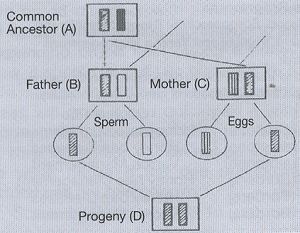
|
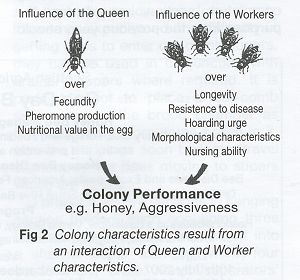
|
|---|---|
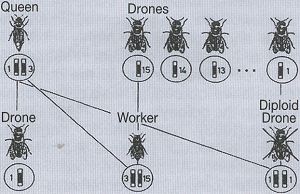
|
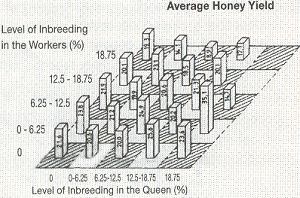
|
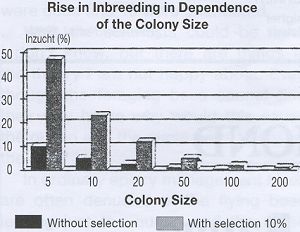
| |
Comments in blue text are those of Dave Cushman as compiler of this web page, other editor's comments are by Nigel Hurst.
On 05 December 2007 I received the following comments fram Jacob Kahn, with permission to add them to the page.
|
Jacob Kahn's comments on the translated version of: Let us start with Fig.1, since the rest of the article hinges on it:
Queens produce two types of drones, in a large scientific scheme especially aided by instrumental insemination (II), you can use as many drones as you like from one particular queen to inseminate another queen and the chances of inbreeding will be as outlined by KB. I would like to comment on two other issues arising in consequence of criticisms on the article.
Jacob Kahn
|
Printed from Dave Cushman's website Live CD version
Written... 04 November to 30 November 2007, Addition... 06 December 2007,
|